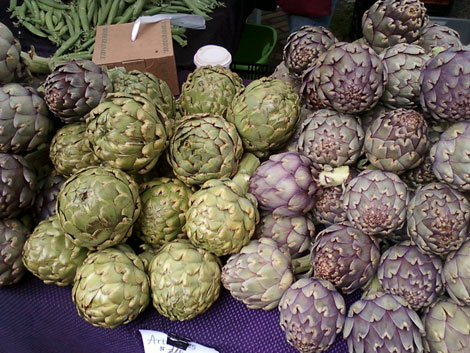I'm not sure I'm getting enough carbs 'cuz I eat very little grains or beans and I am always worried of overdoing fruit.
Well, rest assured that if you are consuming enough calories with your diet, and not exclusively eating fats and proteins, you are most likely getting enough carbohydrates. Carbohydrates exist in just about anything you can eat. By simply eating enough food during the day, you can easily meet your body's carbohydrate requirements.
There are two classifications of carbohydrates: simple and complex. Grains and beans fall under the complex category, while fruits fall under the simple category.
Read more: Am I Getting Enough Carbs Without Beans and Grains?


I am extremely thankful for sleep. I can't imagine striving to sleep only four hours a night. Jim always says he wishes he didn't have to sleep, that he's wasting his life when he sleeps. For me, I've always loved sleeping. I feel so great after I wake up. Not only that, I thoroughly enjoy dreaming. I wouldn't want to miss out on the amazing dream life I've been able to enjoy while I sleep.
Hi everyone!? Sorry for not posting yesterday. Things got crazy-busy on my end, and Wendi is still out of town on her tour. I know poor Deb Young is eagerly awaiting our next installment, as that's the one from Wendi and KDcat's visit to sunny L.A. (during which they had SO much fun and captured some great footage at a raw restaurant there!). However, I honestly do not have a single free moment this week. So, we'll pick up on Monday, April 5 -- by which time our raw travelers will have returned home!? Upcoming posts include:
- Los Angeles -- vids w/ Deb Young, visits to raw restauranrs
- Las Vegas -- vid interviews @ a raw restaurant there
- Arizona -- some Makin' It Monday stuff & staying w/ raw friends
- New Mexico -- visiting w/ raw friend Terri Mares & all sorts of interesting activity/video
- Oklahoma -- hanging at 105 degrees, & Wendi & Penni's raw event
- St. Louis -- visiting w/ family there & my mom as a guest Makin' It Monday chef!
- Geneseo -- visiting with family!! (Hi Cindy!)
- Chicago -- visiting with Danny & Kathy Living, and a raw event at Whole Foods
Some of those are multi-day posts, too, as we have so many interesting raw food goodies to share!? So, see you soon!
Original Comments
Below, we have included the original comments from this blog post. Additional comments may be made via Facebook, below.
On March 30, 2010, wrote:
You know we're always awaiting your installments. Your fans LOVE PureJeevan!!
You're such a sweet guy, and I even have more of the "inside scoop" on how sweet you are, so I definitely forgive you for not posting every day. Stay happy, and I'll see you in April.
Much love, Terri
On March 31, 2010, wrote:
Thanks Jim! that way I can post about the same time as you!
Mahalo!
aloha
deb
On March 31, 2010, wrote:
I love watching you check out new places - I want to do one of my own - maybe a UK raw tour...hmm...
On April 2, 2010, wrote:
How exciting!

Welcome to Makin' It Monday, Guest Raw Chef edition. Today, Dave Sokulski of www.BirchCenter.com and www.FoodUnderFoot.com gets a little silly while making some delicious raw cacao treats! Enjoy the video:
We had a wonderful weekend that started with a raw food potluck in our home (through the Pittsburgh Raw Food Meetup group). There were about twenty people and so many lovely raw food dishes! I haven't checked the camera, yet, but I hope someone remembered to capture some pictures of the food and guests. It was all very yummy, including the beet pasta I made with a cream sauce. I also made some carob peppermint sweets that KDcat formed into bite-sized balls and arranged them on a platter. A friend of mine told me that the people who show up for raw food potlucks tend to be genuinely nice people, and she was right. It was a pleasure meeting everyone and I look forward to next month's meetup.
The rest of our weekend was spent with our guest, Devaki, who just left a few minutes ago to return to the ashram. She played some beautiful music on the harmonium and she and some other lovely guests filled our home with the beauty and energy of Kirtan chanting. Some of the chants were in English, too. I thought I wouldn't like them as much, but they were just as beautiful as the Indian ones. One of my close friends who was here for the Kirtan told me that I was glowing after the chanting! I love the blissful feeling that comes from chanting and meditation.
Note: This entry is not meant for our regular readers. Search engines are directing people to our page when they enter "mono and headaches" and I want to take this opportunity to reach out to those who may not know about this amazing lifestyle the rest of you already know about! ;-) Plus, I want to help them with their headaches.
Mono and Headaches: Looking for Help
Mononucleosis (Mono) is a common viral illness. When children develop mono, it is usually not obvious since it seems like a normal cold. When teens and adults develop mono, however, the symptoms are much more severe. Most individuals will feel better within about three weeks, but fatigue can continue on for about three months! Who wants to feel ill that long? Who wants to feel tired for MONTHS ! Who wants to suffer from such severe headaches ! Not me, that's for sure.

Read more: Mono and Headaches: This Entry is Not For Our Regular Readers

In this special five-part series, Joanna Steven uncovers where some top vegetarian athletes get their protein. Here's part five, focusing on Tonya Kay's take on this issue.
AVOCADO
Professional dance is of most challenging sports requiring athletes to perform at expert levels of flexibility, strength, coordination and emotional fitness in order to entertain their audiences. Having been vegetarian since age 7, Tonya Kay has built her glorious professional dance career entirely on a vegetarian diet.
Read more: Vegetarian Athletes Share: Top 5 Sources for Animal-free Protein (Part 5 of 5)

Here's a picture I took at Portland's Saturday Market last week. We've been pleasantly surprised to find that artichokes grow rather well here in the Pacific Northwest. We don't recall seeing them much back East, but many of our neighbors grow them (both for the artichokes and, I suspect, as ornamental plants).
I suspect that some raw foodists tend to overlook artichokes because they're so traditionally linked with the image of something steamed, stuffed with breadcrumbs, and drizzled in butter -- so, "cooked," "breaded," and "dairy" all together in one recipe! Being half Italian, I grew up eating them this way. My mother almost never said "artichoke"; she always called them an Italian word that sounded like "ga-GO-che-lee." ?She made them just a few times per year, and they were always a huge treat (and we'd often fight over the hearts -- by far the best part!).


This Thursday I want to give a special "Thank You" to Kevin Gianni. He was on my list for a Take the Time Tuesday introduction, but I didn't want to wait until then to tell you about him. I've been following Kevin's work on the Internet since he hosted The Raw Food World Summit last year. You can tell when you hear him speak that he's a genuinely nice, intelligent, caring person. He's honestly listening to what people are saying, trying to absorb the plethora of health information that's available. He asks a lot of interesting questions, too. He then takes what he has learned, condenses it, and shares the knowledge with the rest of the world. He does all of the hard work for us! For this, I wanted to give a special thanks to him.

I'm in the mood to eat lemons, so I figured for today's Makin' It Monday I'd search the Net for some lemon recipes. Well, look what I found!


Jim here... Here's an interesting way to finish out the week: Today just happens to be my one-year "rawniversary." That's right, for the past full year, I've existed as a 100% raw food vegan.
Sure, I'd been "high-raw" for a couple of years prior to September 18, 2008 -- and it was during those high-raw years when the bulk of my weight came off and when I kissed prescription meds goodbye (I'd been on powerful beta-blockers for my heart and blood pressure).

